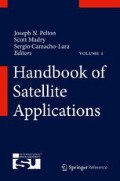Abstract
The first commercial mobile satellite service (MSS) system was implemented to meet the urgent needs of the maritime community for improved communications. As enhancements occurred in satellite technology and circuit integration resulted in availability of low-cost digital signal processors, MSS systems were deployed to support smaller earth terminals for aeronautical and land mobile applications. The growth of the Internet and improved wireless access has led existing MSS system operators to introduce new capabilities that include improved data and multimedia access. This transformation in the MSS markets has offered several technology challenges, particularly with higher power spot beam satellite deployment designed to operate with low-cost personal user terminals.
This chapter addresses the history and evolution of the technology starting with the Marisat system in the 1970s. This historical review covers both the space technology and user terminals, as well as the market characteristics of the various types of MSS systems. Some systems have not been successful in the market and have not done well financially for reasons associated with market demand, cost, and reliability of service and technology. Currently, there is a convergence of terrestrial wireless services with mobile satellite services. One approach has been to offer dual frequency band handsets that switch from one band to the other depending upon whether the user is within the terrestrial system’s coverage. The other approach is for the MSS system operator to support both satellite and terrestrial coverage in the MSS frequency bands to achieve seamless operation for the user. The demand for very high data rates for better Internet access had also led to a convergence of MSS and FSS system capabilities, where many of the capabilities of an MSS are being offered by FSS system operators and vice versa. Fortunately, continuing innovations are assuring mobile users the availability of reliable communications from anywhere in the world.
Access this chapter
Tax calculation will be finalised at checkout
Purchases are for personal use only
References
J. Evans, Satellite and personal communications, in 15th AIAA International Communications Satellite Systems Conference, San Diego, February/March 1994, pp. 1013–1024
B. Gallagher (ed), Never Beyond Reach – The World of Mobile Satellite Communications (International Maritime Satellite Organization, 1989)
R.K. Gupta, Low cost satellite user terminals: lessons from the wireless industry, in 22nd AIAA Conference on Satellite Communications Systems, Monterey, June 2004
P. Karabinis, S. Dutta, Recent Advances that may revitalize Mobile Satellite Systems. LightSquared, www.lightsquared.com
S. Lee, et al., The wireless broadband system for broadband wireless Internet services. IEEE Commun. Mag. 106–113 (July 2006)
D.W. Lipke, D.W. Swearingen, Communications system planning for MARISAT, in International Conference on Communications, Minneapolis, June 1974, IEEE Cat. No. CHO859-9-CSCB
E. Reinhart, R. Taylor Mobile communications and space communications. IEEE Spect. 27–29 (1992)
E.J. Martin, L.M. Keane, MARISAT-Gapfiller for navy satellite communications. Signal Mag. (Nov./Dec. 1974)
D.W. Swearingen, D.W. Lipke, MARISAT Multiple Access Capabilities, in International Conference on Communications, Philadelphia, June 1976, IEEE Cat. No. 76CH1086-0CSCB
D. Whalen, G. Churan, The American Mobile Satellite Corporation space segment, in 14th AIAA Conference on Satellite Communications, Washington, DC, March 1992, pp. 394–404
Author information
Authors and Affiliations
Corresponding author
Editor information
Editors and Affiliations
Rights and permissions
Copyright information
© 2013 Springer Science+Business Media New York
About this entry
Cite this entry
Gupta, R., Swearingen, D. (2013). Mobile Satellite Communications Markets: Dynamics and Trends. In: Pelton, J.N., Madry, S., Camacho-Lara, S. (eds) Handbook of Satellite Applications. Springer, New York, NY. https://doi.org/10.1007/978-1-4419-7671-0_7
Download citation
DOI: https://doi.org/10.1007/978-1-4419-7671-0_7
Publisher Name: Springer, New York, NY
Print ISBN: 978-1-4419-7670-3
Online ISBN: 978-1-4419-7671-0
eBook Packages: EngineeringReference Module Computer Science and Engineering

